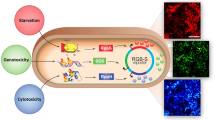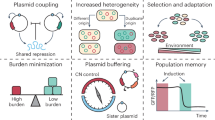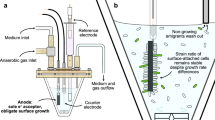Abstract
Individual-based microbial ecology (IBME) is a developing field of study in need of experimental tools to quantify the individual experience and performance of microorganisms in their natural habitats. We describe here the conception and application of a single-cell bioreporter approach with broad utility in IBME. It is based on the dilution of stable green fluorescent protein (GFP) in dividing bacteria. In the absence of de novo synthesis, GFP fluorescence of a daughter cell approximates half of that of its mother, from which follows that the fluorescence of a progeny cell is a quantitative measure for the reproductive success of its ancestor. To test this concept, we exposed GFP-filled bacteria to different degrees of environmental heterogeneity and assessed how this affected individual cells by the analysis of GFP content in their progeny. Reporter bacteria growing in rich medium in a shaking flask showed no variation in reproductive success, confirming that life in a broth is experienced much the same from one bacterium to the next. In contrast, when reporter bacteria were released onto plant leaf surfaces, representing a microscopically heterogeneous environment, clear intrapopulation differences in reproductive success were observed. Such variation suggests that individual cells in the founding population experienced different growth-permitting conditions, resulting in unequal contributions of individual bacteria to future offspring and population sizes. Being able to assess population changes bottom-up rather than top-down, the bioreporter offers opportunities to quantify single-cell competitive and facilitative interactions, assess the role of chance events in individual survivorship and reveal causes that underlie individual-based environmental heterogeneity.
Similar content being viewed by others
Log in or create a free account to read this content
Gain free access to this article, as well as selected content from this journal and more on nature.com
or
References
Axtell CA, Beattie GA . (2002). Construction and characterization of a proU-gfp transcriptional fusion that measures water availability in a microbial habitat. Appl Environ Microbiol 68: 4604–4612.
Brandl MT, Quinones B, Lindow SE . (2001). Heterogeneous transcription of an indoleacetic acid biosynthetic gene in Erwinia herbicola on plant surfaces. Proc Nat Acad Sci USA 98: 3454–3459.
Brehm-Stecher BF, Johnson EA . (2004). Single-cell microbiology: tools, technologies, and applications. Microbiol Mol Biol Rev 68: 538–559.
Davey HM, Kell DB . (1996). Flow cytometry and cell sorting of heterogeneous microbial populations: the importance of single-cell analyses. Microbiol Rev 60: 641–696.
Davey HM, Winson MK . (2003). Using flow cytometry to quantify microbial heterogeneity. Curr Issues Mol Biol 5: 9–15.
Davidson CJ, Surette MG . (2008). Individuality in bacteria. Annu Rev Genet 42: 253–268.
Green J, Bohannan BJM . (2006). Spatial scaling of microbial biodiversity. Trends Ecol Evol 21: 501–507.
Gunasekera TS, Sundin GW . (2006). Role of nucleotide excision repair and photoreactivation in the solar UVB radiation survival of Pseudomonas syringae pv. syringae B728a. J Appl Microbiol 100: 1073–1083.
Harms H, Wells MC, van der Meer JR . (2006). Whole-cell living biosensors—are they ready for environmental application? Appl Microbiol Biotechnol 70: 273–280.
Hellweger FL, Bucci V . (2009). A bunch of tiny individuals—individual-based modeling for microbes. Ecol Modell 220: 8–22.
Jaspers MCM, Meier C, Zehnder AJB, Harms H, van der Meer JR . (2001). Measuring mass transfer processes of octane with the help of an alkS-alkB∷gfp-tagged Escherichia coli. Environ Microbiol 3: 512–524.
Joyner DC, Lindow SE . (2000). Heterogeneity of iron bioavailability on plants assessed with a whole-cell GFP-based bacterial biosensor. Microbiology 146: 2435–2445.
Leveau JHJ . (2006). Microbial communities in the phyllosphere. In: Riederer M and Mueller C (eds). Biology of the Plant Cuticle. Blackwell Publishing Ltd: Oxford, UK, pp 334–367.
Leveau JHJ, Lindow SE . (2001a). Appetite of an epiphyte: quantitative monitoring of bacterial sugar consumption in the phyllosphere. Proc Nat Acad Sci USA 98: 3446–3453.
Leveau JHJ, Lindow SE . (2001b). Predictive and interpretive simulation of green fluorescent protein expression in reporter bacteria. J Bacteriol 183: 6752–6762.
Leveau JHJ, Lindow SE . (2002). Bioreporters in microbial ecology. Curr Opin Microbiol 5: 259–265.
Mailloux BJ, Fuller ME . (2003). Determination of in situ bacterial growth rates in aquifers and aquifer sediments. Appl Environ Microbiol 69: 3798–3808.
Maksimow M, Hakkila K, Karp M, Virta M . (2002). Simultaneous detection of bacteria expressing gfp and dsred genes with a flow cytometer. Cytometry 47: 243–247.
Melbourne BA, Cornell HV, Davies KF, Dugaw CJ, Elmendorf S, Freestone AL et al. (2007). Invasion in a heterogeneous world: resistance, coexistence or hostile takeover? Ecol Lett 10: 77–94.
Monier JM, Lindow SE . (2003). Differential survival of solitary and aggregated bacterial cells promotes aggregate formation on leaf surfaces. Proc Nat Acad Sci USA 100: 15977–15982.
Monier JM, Lindow SE . (2004). Frequency, size, and localization of bacterial aggregates on bean leaf surfaces. Appl Environ Microbiol 70: 346–355.
Morris CE, Monier JM, Jacques MA . (1998). A technique to quantify the population size and composition of the biofilm component in communities of bacteria in the phyllosphere. Appl Environ Microbiol 64: 4789–4795.
Prosser JI, Bohannan BJM, Curtis TP, Ellis RJ, Firestone MK, Freckleton RP et al. (2007). The role of ecological theory in microbial ecology. Nature Rev Microbiol 5: 384–392.
Roostalu J, Joers A, Luidalepp H, Kaldalu N, Tenson T . (2008). Cell division in Escherichia coli cultures monitored at single cell resolution. BMC Microbiol 8: 68.
Rosenfeld N, Perkins TJ, Alon U, Elowitz MB, Swain PS . (2006). A fluctuation method to quantify in vivo fluorescence data. Biophys J 91: 759–766.
Sandhu A, Halverson LJ, Beattie GA . (2007). Bacterial degradation of airborne phenol in the phyllosphere. Environ Microbiol 9: 383–392.
Scheiner S, Willig M . (2008). A general theory of ecology. Theor Ecol 1: 21–28.
Shaner NC, Campbell RE, Steinbach PA, Giepmans BNG, Palmer AE, Tsien RY . (2004). Improved monomeric red, orange and yellow fluorescent proteins derived from Discosoma sp. red fluorescent protein. Nat Biotechnol 22: 1567–1572.
Tecon R, van der Meer JR . (2006). Information from single-cell bacterial biosensors: what is it good for? Curr Opin Biotechnol 17: 4–10.
Templeton AR, Rothman ED . (1978). Evolution in fine-grained environments: 1. environmental runs and evolution of homeostasis. Theor Popul Biol 13: 340–355.
Woody ST, Ives AR, Nordheim EV, Andrews JH . (2007). Dispersal, density dependence, and population dynamics of a fungal microbe on leaf surfaces. Ecology 88: 1513–1524.
Acknowledgements
We thank Maria Marco for useful comments on the paper and Steve Lindow for his support in the conception phase of the project. Funding was provided by the Netherlands Organisation of Scientific Research (NWO) in the form of a personal VIDI grant to JHJL. This is NIOO-KNAW publication 4626.
Author information
Authors and Affiliations
Corresponding author
Rights and permissions
About this article
Cite this article
Remus-Emsermann, M., Leveau, J. Linking environmental heterogeneity and reproductive success at single-cell resolution. ISME J 4, 215–222 (2010). https://doi.org/10.1038/ismej.2009.110
Received:
Revised:
Accepted:
Published:
Issue date:
DOI: https://doi.org/10.1038/ismej.2009.110
Keywords
This article is cited by
-
Metabolic resource overlap impacts competition among phyllosphere bacteria
The ISME Journal (2023)
-
Weather stressors correlate with Escherichia coli and Salmonella enterica persister formation rates in the phyllosphere: a mathematical modeling study
ISME Communications (2022)
-
A functional perspective on phenotypic heterogeneity in microorganisms
Nature Reviews Microbiology (2015)
-
Modeling microbial growth and dynamics
Applied Microbiology and Biotechnology (2015)
-
Microbial life in the phyllosphere
Nature Reviews Microbiology (2012)



